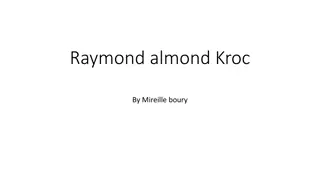The Evolution of Pink Floyd: From Humble Beginnings to Iconic Progressive Rock Pioneers
Pink Floyd originated from the friendship of Roger Waters and Nick Mason, evolving through various band names until settling on Pink Floyd. The band's journey, marked by musical experimentation and lineup changes, culminated in their rise to fame with hit albums and chart-topping singles. Syd Barrett's departure led to a shift in the band's dynamics, ultimately paving the way for Pink Floyd's iconic sound under the leadership of Roger Waters. The band's discography reflects their innovative approach to music, blending psychedelic rock with thought-provoking lyrics and groundbreaking soundscapes.
Download Presentation

Please find below an Image/Link to download the presentation.
The content on the website is provided AS IS for your information and personal use only. It may not be sold, licensed, or shared on other websites without obtaining consent from the author.If you encounter any issues during the download, it is possible that the publisher has removed the file from their server.
You are allowed to download the files provided on this website for personal or commercial use, subject to the condition that they are used lawfully. All files are the property of their respective owners.
The content on the website is provided AS IS for your information and personal use only. It may not be sold, licensed, or shared on other websites without obtaining consent from the author.
E N D
Presentation Transcript
PINK FLOYD By: Sierra Marler
BIOGRAPHY OF PINK FLOYD Friends Roger Waters and Nick Mason started a band under Sigma 6 in 1963. Classmate, Richard Wright joined soon after. Went through a variety of name changes such as The Meggadeaths, Screaming Abdabs, Leonard s Lodgers, and the Spectrum Five before setting with The Tea Set. Preformed covers of R&B songs. In 1965, Roger Waters childhood friend, Syd Barrett joined the band. With his creative ways, Syd became the main guitarist and front man of the band. Played shows under The Tea Set until they found out another band had that name at one of the same gigs. On the spot, Syd came up with the name the Pink Floyd Sound but years later dropped sound from the name and became known as Pink Floyd. Syd took the name from his favorite blues musicians, Pink Anderson and Floyd Council.
BIOGRAPHY CONT. By 1966, Pink Floyd became a full time band Starting experimenting with psychedelic sounds Became one of the first bands to play 90 minutes sets and add extravagant lights to the show Pink Floyd signed to EMI records in 1967 and released their first singles Arnold Layne and See Emily Play Arnold Layne was banned from many radio stations due to what the song was about.
BIOGRAPHY CONT. In 1967, Pink Floyd released their first album, The Piper at the Gates of Dawn Reached #6 on the British Album Charts Made the band popular and Syd Barrett the star By the end of 1967, Syd Barrett became mentally unstable and had a psychotic break The band added David Gilmour to the band to play the guitar in place of Syd but to keep Syd as a writer Beginning of 1968, Syd Barrett and the band decided to part ways. Syd released 2 solo albums in1970 but eventually moved back home and stayed their till his death Only known picture of all 5 band members and Syd being distance before his departure from the band.
BIOGRAPHY CONT. With Syd gone, the music and lyrics fell responsibility of Roger Waters Released 2nd studio album in 1968, A Saucerful of Secrets, which contained only one song written and sung by Syd Barrett before his departure from the band Produced a soundtrack for the movie Morein summer of 1969 Only four months later, released their 4th studio album, Ummagumma, reaching #5 on the UK music charts First album which contained a different sound from the previous influences of Syd 5th studio album, Atom Heart Mother, was released in 1970. First album to reach #1 on the UK music charts Was the album that the band started making money on Released their 6th studio album,Meddle, in 1971 which reached #3 on the UK music charts Produced another soundtrack for a French film in 1972 Success in America still eluded them
BIOGRAPHY CONT. Dark Side of the Moon was released in March of 1973 as Pink Floyd s 8th studio album With the release of the single Money , Pink Floyd became an American sensation going straight to #1 on the Billboard charts and #2 in UK s music charts Dark Side broke all records, staying on the Billboard charts for 741 weeks and became the most commercially successful rock album of all time This brought tremendous wealth and fame to the band
BIOGRAPHY CONT. Pink Floyd returned to the studios to record their 9th studio album, Wish You Were Here Contains most popular singles of Wish You Were Here and Shine On You Crazy Diamond Band was mentally and physically drained from the success of their last album Released in September of 1975 and when straight to #1 on the music charts in the U.S and the UK
BIOGRAPHY CONT. Personal, financial, and creative differences continued to get in between band members Pink Floyd continued to release their 10th studio album, Animals, in 1977 despite their disagreements In 1979, Pink Floyd released another best selling album, The Wall which they produced a live action/animated musical film with in 1982 as Pink Floyd The Wall Conflicts continue to grow in the band. Pink Floyd was able to release The Final Cut in March of 1983 before Roger Waters announced his departure from the band and the possibility of the end of Pink Floyd
BIOGRAPHY CONT. After brutal court battles, David Gilmour, Nick Mason, and Richard Wright won the right to continue on with the music and name of Pink Floyd Without Roger Waters, Pink Floyd released A Momentary Lapse of Release in 1987 and The Division Bell in 1994 Though all music of Pink Floyd stopped in 1994, Pink Floyd was inducted into the Rock & Roll Hall of Fame in 1996 In 2005, all band members, including Roger Waters, joined the stage at LIVE 8 performing as Pink Floyd in over 24 years
BIOGRAPHY CONT. On July of 2006, original founding member of Pink Floyd, Syd Barrett, died of diabetes at his home in Cambridge at the age of 60 The members of Pink Floyd did not attend his ceremony but credited Barrett as the guiding light of the early years of Pink Floyd Not long after, in September of 2008, the keyboardist of Pink Floyd, Richard Wright dies of cancer at the age of 65. In 2012, David Gilmour and Nick Mason returned to the studio one last time as Pink Floyd to record November of 2014, Pink Floyd released their 15th and final studio album, The Endless River, which is recognized as a tribute to former bandmate Richard Wright
COMPOSITION HISTORY SHINE ON YOU CRAZY DIAMOND: PARTS I-V BY : PINK FLOYD Pink Floyd released their 9th studio album Wish You Were Here in September of 1975 Album contained a nine part composition called Shine on You Crazy Diamond Song was written as a remembrance and testimony of friend & former bandmate Syd Barrett Most celebrated piece in Pink Floyd music collection Wish You Were Here Album cover
COMPOSITION HISTORY CONT. Originally called Shine On but renamed to Shine On You Crazy Diamond Nine part composition was separated in to 2 sections, Parts 1-5 and Parts 6-9 Song was played and recorded during tour in 1974 but had to be re- recorded for the album in 1975 due to instruments bleeding on other parts of the track. Parts 1-5 consist primarily of instrumentals Parts 1-5 became main tracks played during live performances
COMPOSITION HISTORY CONT. During final mixing of Shine On, a random visitor appeared in the studio. Took about 45 minutes for someone to realize that visitor was Syd Barrett. Once lively and slim but was now quiet and overweight. Of all the days to show up, he appeared on the day they were making the final mix on the song that was for him. Disappeared after awhile, and became the last time the band ever saw Syd Barrett. Syd Barrett at the recording studio during the mixing of Shine On
LISTENING GUIDE SHINE ON YOU CRAZY DIAMOND: PARTS I-V Part I 0:00 0:05 0:12 0:18 0:23 0:32 0:34 0:44 0:56 1:00 1:11 1:23 1:30 1:40 Organ comes back in playing over the wine glass harp and synthesizer 2:01 Synthesizer plays what creates a sound of a futuristic computer 2:09 Guitar solo begins in G minor 2:11 Wine harps remain in background as the pulse of the piece Wine glass harps fade in Synthesizer sounds fades in on top of wine glasses Wine glass harps build in volume with occasional sounds of the synthesizer Wine glass harp increases in volume more Organ begins playing on top of the wine glass harp Wine glass harps continue to increase in volume with organ playing over it Synthesizer creates background sounds Organ builds in volume on tops of wine glass harp Synthesizer repeats background sounds Synthesizer creates a background sound again but this time sounding like a xylophone Organ continues over wine glass harps creating a haunting feeling Synthesizer create more background noise. Sounding like wind chimes in a slight breeze Organ fades out leaving wine glass harps and synthesizer
LISTENING GUIDE (CONT.) SHINE ON YOU CRAZY DIAMOND: PARTS I-V 2:13 Guitar plays a bluesy sound setting the tone of melancholy 2:23 The organ pipes in changing keys and reminding you it is still there 2:33 Organ s changes keys again 2:39 Guitar solo continues with a weeping/crying sound 3:04 Organ s key changes again 3:14 Organ continues to go back and forth on different keys in minor mode 3:30 Guitar solo fades out on ending note 3:40 Part II Wine glass harps and organ decrease in volume 3:54 This 4 note chord in minor mode introduces part II of the composition. This theme becomes known as Syd s theme 3:59 Wine glass harps and organ volume stay low in the background 4:05 Syd s theme is repeated for the second time 4:08 Synthesizer in the background sounding like the slight movement of wind chimes 4:17 Syd s theme repeats a third time 4:22 Syd s theme repeats a fourth time leading it into the harmony 4:24 The drums and bass come in building up to a major mode. 4:28 You hear Syd s theme repeat in the background
LISTENING GUIDE (CONT.) SHINE ON YOU CRAZY DIAMOND: PARTS I-V 4:29 Drums, guitar and bass come in with strength 4:34 Syd s theme repeats now in a fixed tempo 4:44 Syd s theme is repeated over rest of the instruments 4:50 The guitar changes keys 5:05 Syd s theme repeats 5:11 Beginning of the guitar solo for part II of the composition 5:16 Syd s theme repeats 5:22 Guitar solo continues in major mode 5:42 The bass becomes more prominent and echoes the guitar 5:44 The organ comes from the background increasing in volume and then falls back into the background 5:59 Syd s theme repeats one last time blending into the guitar solo 6:04 Guitar increase in volume 6:24 Guitar begins to fade out Part III 6:27 As the guitar fades out, the synthesizer horn comes in for a solo 6:47 The drums and guitar add an extra step to the melody as the synthesizer solo continues
LISTENING GUIDE (CONT.) SHINE ON YOU CRAZY DIAMOND: PARTS I-V 6:58 The synthesizer solo continues creating a sway, while the bass and drums keep the rhythm in the background 7:11 The rhythm guitar changes chords creating a brighter feeling like the sunshine peaking with the clouds on a rainy day 7:30 They synthesizer solo ends, the background music quiets except the drums who plays two beats with the cymbals 7:32 The last cymbal beat introduces the third guitar solo of the composition in a G minor 7:49 The drums keep the beat and tempo going 8:36 The guitar fades out, ending the guitar solo 8:37 The drums keep the rhythm going with the clap of the cymbals Part IV 8:42 The vocals begin introducing part IV of the composition and the guitar plays in G minor 8:47 Back vocals come in and harmonize 8:51 Chord changes with chorus to E flat, D minor, C minor, B flat, F 9:02 Female vocals keep the harmony singing oooh s and guitar goes back to G minor from chorus 9:12 Chorus repeats in same chords 9:44 Small guitar solo 10:05 Vocals come back 10:15 Chorus repeats in same chords
LISTENING GUIDE (CONT.) SHINE ON YOU CRAZY DIAMOND: PARTS I-V 10:25 Vocals continue and female vocals come back harmonizing with oooh s 10:36 Chorus repeats, same chords 10:45 Female harmonizing vocals change to aaah s 11:07 As the last words in the vocals are being sung, the baritone saxophone enter Part V 11:10 The entering of the saxophone introduces part V of the composition and the saxophone solo. The synthesizer keyboard comes in and supports the saxophone in the background 11:11 Syd s four chord theme re-enters 11:21 Syd s theme repeats and goes straight into 2 guitars repeating on arpeggio variation 11:59 The solo continues but changes from baritone to tenor saxophone. The drums and bas change its beat to more of a blues/swing vibe 12:41 All music stops except the saxophone and background synthesizer, and repeating guitars 12:55 The saxophone, synthesizer, and repeating guitars decrease in volume 13:01 Repeating guitars fade out and a humming machine noise fades in 13:08 Synthesizer and saxophone begin to fade out 13:13 Machine like humming gets louder 13:28 Saxophone is in the far distance and machine like humming has become the main sound 13:31 Fin
BIBLIOGRAPHY Biography.com Editors. "Syd Barrett." Bio.com. A&E Networks Television, n.d. Web. 2 Mar. 2016. Buskin, Richard. "Pink Floyd 'Shine On You Crazy Diamond'" Pink Floyd 'Shine On You Crazy Diamond' Sound on Sound, Dec. 2014. Web. 1 Mar. 2016. DeRogatis, Jim. "Chapter 5: Pipers at the Gates of Dawn." Turn on Your Mind: Four Decades of Great Psychedelic Rock. Milwaukee, WI: Hal Leonard, 2003. 123-49. Print. Gilmore, M. (2008) Stories Done: Writings on the 1960s and its disconnects. New York: Free Dress. "Pink Floyd Biography." Pink Floyd Biography. The Rock and Roll Hall of Fame + Museum, n.d. Web. 1 Mar. 2016. "Pink Floyd Biography." Rolling Stone. N.p., n.d. Web. 26 Mar. 2016. Povey, G. (2010) Echoes: The Complete History of Pink Floyd. Chicago, IL: Chicago Review Press. "Shine On You Crazy Diamond." Project Gutenberg Self-Publishing Press. World Public Library Association, n.d. Web. 1 Mar. 2016. White, Dave. "Syd Barrett." About.com Entertainment. About Entertainment, n.d. Web. 1 Mar. 2016.


![[PDF⚡READ❤ONLINE] Planet Mercury: From Pale Pink Dot to Dynamic World (Springer](/thumb/21549/pdf-read-online-planet-mercury-from-pale-pink-dot-to-dynamic-world-springer.jpg)



















